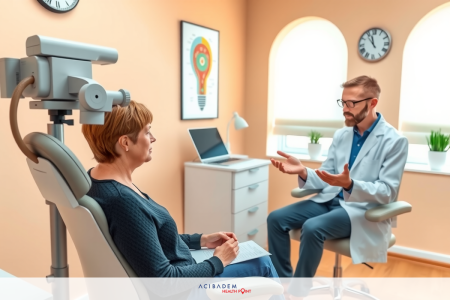Conjunctival Pyogenic Granuloma Benign ocular condition, known as conjunctival pyogenic granuloma, happens on the eye’s outer layer. This often comes from injuries or surgeries. It looks red and fleshy and can hurt. Sometimes, it even bleeds. Knowing about this health issue is important for the people it affects and doctors offering care. Treatment can mix medicine and surgery, made for each patient.
Understanding Conjunctival Pyogenic Granuloma
Conjunctival pyogenic granuloma is when tissue grows too much on the eye’s conjunctiva. It often happens after an injury or surgery. This growth can be red or pink and can hurt your eyes or affect your vision.
What is a Conjunctival Pyogenic Granuloma?
This kind of growth comes from an inflammation. It’s not cancer but it can grow big and look bad. It usually looks like a small, raised bump. And because it’s full of blood vessels, it looks very red and fleshy.
Common Signs and Symptoms
It’s important to know the signs early. You might see:
- Redness in the affected area
- Tenderness around the nodule
- Occasional bleeding
- Discomfort or irritation in the eye
These can make everyday things hard and lower your life quality.
Causes and Risk Factors
Ocular surgeries and eye injuries make you more likely to get this. Also, infections in the conjunctiva can start it too.
- Ocular surgeries
- Eye injuries
- Infections affecting the conjunctiva
They all can lead to an inflammation that causes the granuloma to form.
Diagnosis of Conjunctival Pyogenic Granuloma
Finding out you have a conjunctival pyogenic granuloma is key. It starts with a deep ocular examination. Your eye doctor will look closely at your eye. They check for growth and how healthy your eye is. Finding these growths takes skill and careful looking.
Medical imaging for eye growths helps the doctor dig deeper. Ultrasound biomicroscopy is one useful tool. It shows the doctor detailed images of the problem. This helps them know its size, depth, and how it affects nearby tissues. If the growth seems not right, a biopsy may happen. This is to be sure it’s not cancer. Using these tools together, doctors can plan the best treatment for you.
| Diagnostic Method | Description | Purpose |
|---|---|---|
| Ocular Examination | A comprehensive visual inspection of the eye by an ophthalmologist. | Identify visible signs of the conjunctival mass. |
| Ultrasound Biomicroscopy | High-frequency ultrasound imaging to assess the lesion. | Determine the size, depth, and impact of the growth. |
| Biopsy | Extraction of tissue from the lesion for microscopic analysis. | Confirm the benign nature or identify malignant properties. |
Treatment Options for Conjunctival Pyogenic Granuloma
There are many ways to treat a conjunctival pyogenic granuloma. Doctors choose the best way based on the granuloma’s size, where it is, and if it comes back often. This makes sure the treatment is safe and works well for each person.
Non-Surgical Treatments
Doctors first try treatments that don’t involve surgery. These can help heal a pyogenic granuloma without an operation. These treatments include:
- Topical Corticosteroids: These are special eye drops that help with swelling and can make the granuloma smaller.
- Observation: Sometimes, watching the granuloma closely is enough. It might get better on its own without surgery.
Surgical Interventions
If the non-surgical treatments don’t work, surgery might be needed. Doctors then remove the granuloma by surgery. Surgical choices are:
- Excision: A surgery to take out the granuloma through a tiny cut.
- Laser Therapy: A treatment that uses a laser to remove the granuloma. It’s gentle with a fast recovery.
Post-Treatment Care
It’s important to care for the eye after treatment to help it heal well. After surgery, the care often includes:
- Taking medicine to fight off germs and help with the swelling.
- Going for check-ups to make sure the eye is healing right and the granuloma doesn’t come back.
Good care after any treatment can make a big difference for people with a pyogenic granuloma. It helps them recover faster and keeps the granuloma from coming back.
Acibadem Healthcare Group and Treatment Approaches
The Acibadem Healthcare Group helps a lot with eye issues like conjunctival pyogenic granuloma. It has top-notch places and cares a lot for patients. They make sure everyone gets great treatment that fits them well.
Why Choose Acibadem Healthcare Group?
Going to the Acibadem Healthcare Group means choosing new and great eye care. They mix the best tech with care made for you. This way, everyone gets the right help from top eye doctors.
Expertise in Eye Care
The Acibadem Healthcare Group has a strong eye care team. Their doctors are experts who know a lot. They use the newest ways to fix eye problems like conjunctival pyogenic granuloma really well.
Patient Testimonials
People love the care at Acibadem Healthcare Group. Many happy patients say they got better so fast. They thank the group for caring so much and for having doctor experts. This praise shows how good Acibadem is, making it a trusted place for eye help.
Prevention of Eye Growths and Conjunctival Lesions
Stop conjunctival tumors and other eye growths with smart steps. Start by avoiding eye injuries. Put on safety goggles when you might hit or hurt your eyes. This keeps them safe. Also, keep your eyes clean to stop infections. Don’t touch things that can irritate or harm your eyes.
If you had eye surgery, follow what the doctor says carefully. Use your medicine like you should. And go to all your check-up visits. This helps your eyes heal right and lets doctors see problems early.
Getting your eyes checked often is a big deal. It helps find and treat eye problems early, like conjunctival tumors. Go see an eye doctor regularly. This keeps your eyes healthy and your mind at ease.
- Wear safety goggles to avoid eye injuries
- Maintain good hygiene to prevent infections
- Follow post-surgical care instructions meticulously
- Attend regular eye check-ups
Difference Between Conjunctival Pyogenic Granuloma and Other Ocular Conditions
Distinguishing conjunctival pyogenic granuloma from other eye problems is very important. It helps in getting the right treatment. It is different from eye tumors, granulomas, and common eye infections. Each problem needs its own care. Knowing these differences is good for the patient’s health.
Conjunctival Tumors
Conjunctival tumors are growths on the eye’s surface, which can be harmless or cancerous. Different from pyogenic granulomas, which are often harmless. Signs to look for include a weird shape and color, and if they spread to other parts. Fast checkups and maybe a biopsy are needed to know for sure.
Ocular Granuloma
Ocular granuloma happens with granulomatous conjunctivitis. It is when the eyes get masses from infections, immune diseases, or when something gets into the eye. This causes long-lasting inflammation. It is important to treat these differently from pyogenic granulomas. Knowing the reasons behind it is key to getting better.
Common Eye Inflammations
Common eye problems, like pink eye, show different signs than pyogenic granulomas. They often make the eye very red, swollen, and watery, covering more of the eye. These problems need anti-inflammatory drugs and to fix what caused them. This is not the same as treating conjunctival pyogenic granulomas or tumors.
| Condition | Characteristics | Treatment Approaches |
|---|---|---|
| Conjunctival Pyogenic Granuloma | Benign, vascular nodule, red and fleshy, often post-trauma/surgery | Topical corticosteroids, surgical excision, laser therapy |
| Conjunctival Tumors | May be benign or malignant, irregular shape, potential tissue invasion | Biopsy, surgical removal, possible radiotherapy/chemotherapy |
| Ocular Granuloma | Inflammatory mass, linked with granulomatous conjunctivitis | Treat infections or underlying autoimmune conditions, corticosteroids |
| Common Eye Inflammations | Redness, swelling, discharge across a larger conjunctival area | Anti-inflammatory medications, addressing underlying cause |
Living with Conjunctival Pyogenic Granuloma
Handling conjunctival pyogenic granuloma well can really boost life quality with this eye issue. Following the treatment plan closely is key, be it meds or surgery. Seeing your eye doctor often is vital to keep track of how you’re doing and to make any needed changes.
Dealing with how your eyes look and feel can be hard. It’s important to have a support system. Family, friends, and talking to someone like a counselor can make it easier. Learning about eye health and how the issue can come back can help you take better care of yourself.
Here are some smart moves to make life better while dealing with eye diseases:
- Always use the medicines your doctor prescribes.
- Wear protective gear to keep your eyes safe from harm.
- Go for check-ups regularly to catch any problems early.
- Eat well, drink enough water, and keep your eyes in good shape.
Knowing how to manage conjunctival pyogenic granuloma means you can handle it better. Dealing with the tough parts, both physically and mentally, helps keep a good life quality. This makes sure your eye health care is well-rounded.
The Importance of Regular Eye Check-ups
It’s very important to get your eyes checked often. This helps catch any problems early. Doctors can see if your eyes are okay. They check for things that could become hurts or sicknesses.
How often you should go to the eye doctor depends on you. Your age and health matter. The doctor checks your eyes very well. They look for small changes. Then they can help you right away if needed.
Going to the eye doctor regularly is smart. Early signs of trouble can be found. This makes your eyes stay healthy. It also helps your eyes see better for a long time.
| Age Group | Recommended Frequency | Key Monitoring Aspects |
|---|---|---|
| Children (6 months – 18 years) | Every 1-2 years | Vision development, early disease detection |
| Adults (18-60 years) | Every 2 years | Refractive errors, ocular health monitoring |
| Seniors (60+ years) | Annually | Detection of age-related conditions, maintaining vision quality |
Getting your eyes checked is key to keeping them healthy. It’s best to do this often. Seeing the doctor can catch problems fast. This helps keep your eyes and their health in good shape.
Research and Advancements in Conjunctival Mass Treatments
Ongoing research in ophthalmology is changing how we treat eye growths like conjunctival masses. Breakthroughs in surgery, new medicines, and therapies that don’t need surgery are making treatments better and easier for patients. These new ways to treat eye growths are very important. They help patients get better and make care better.
Surgery is a big focus for making treatments better. Newer surgeries are smaller and cause fewer problems. Lasers and cryotherapy are also being used more. They help treat eye growths while keeping the rest of the eye safe.
Research into eye growth medicine is also going well. Scientists are looking for creams or drops that can help without surgery. They are also checking out how our genes affect these eye growths. This might lead to better treatments to stop them from coming back.
It’s very important for doctors and patients to keep up with these new treatments. Knowing about the latest can help doctors give the best care. Patients can also understand more about their choices. Learning about new treatments helps everyone who has these eye growths.
FAQ
What is a Conjunctival Pyogenic Granuloma?
A conjunctival pyogenic granuloma is a small, red bump that grows on the eye's tissue. It usually happens after an eye injury or surgery. It looks fleshy and can bleed and feel sore. Doctors can treat it with medicine or a small procedure.
What are the common signs and symptoms of conjunctival pyogenic granuloma?
Signs and symptoms include a red or pink bump that is sore. It might sometimes bleed. It often shows up after an injury or surgery.
What causes conjunctival pyogenic granuloma?
Injury or surgery on the eye can lead to this condition. It may also follow eye infections. Doctors link it to these issues.
How is conjunctival pyogenic granuloma diagnosed?
An eye doctor checks the eye for any unusual bumps. They might do special eye tests too. This helps them understand more about the bump.
If needed, they might remove a small piece for testing. This makes sure it's not something worse.
What are the non-surgical treatments for conjunctival pyogenic granuloma?
Doctors can use special drops to calm the soreness. They also keep a close eye on it. This care can help it go away without surgery.
What surgical interventions are available for conjunctival pyogenic granuloma?
If needed, a doctor can remove the bump with a small surgery. A laser might also be used. This is when the bump keeps coming back or bothers you a lot.
What should I expect during post-treatment care for conjunctival pyogenic granuloma?
After care might include using special eye drops. This is to prevent it from coming back. You'll need to see your eye doctor regularly for a check-up.
Why choose Acibadem Healthcare Group for treating conjunctival pyogenic granuloma?
At Acibadem, we offer top technology and an expert eye team. We focus on what's best for you. Our goal is top-notch care and your happiness.
How can I prevent conjunctival pyogenic granuloma and other eye growths?
Keep your eyes safe from harm and protect them from infections. Always use safety gear when necessary. Follow your surgery instructions closely. Check your eyes regularly for anything unusual.
What is the difference between conjunctival pyogenic granuloma and other ocular conditions?
Conjunctival pyogenic granuloma is usually not serious, seen as a red or pink bump. Other eye issues have different signs and treatments. Getting the right diagnosis is key for treating it right.
How can I manage living with conjunctival pyogenic granuloma?
Stick to your treatment and keep up with eye checks. If it's hard, talk to an eye specialist. Getting support can make a big difference.
What is the importance of regular eye check-ups?
Seeing your eye doctor often is vital. They can catch eye issues early, stopping them from getting worse. This helps keep your eyes healthy.
What research and advancements are being made in the treatment of conjunctival pyogenic granuloma?
There's always new research to find better ways to treat this condition. Better surgery, medicine, and non-surgery methods mean a more comfy and effective treatment. The goal is to offer the best care possible.













